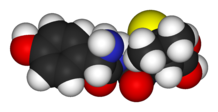 |
|
 |
|
|
Amoxicillin
|
|
| Systematic (IUPAC) name | |
| 7-[2-amino-2-(4-hydroxyphenyl) -acetyl]amino-3,3-dimethyl-6-oxo -2-thia-5-azabicyclo[3.2.0]heptane -4-carboxylic acid | |
| Identifiers | |
| CAS number | 26787-78-0 |
| ATC code | J01CA04 |
| PubChem | 33613 |
| DrugBank | APRD00248 |
| Chemical data | |
| Formula | C16H19N3O5S |
| Mol. weight | 365.4 g/mol |
| Pharmacokinetic data | |
| Bioavailability | 95% oral |
| Metabolism | less than 30% Hepatic biotransformed |
| Half life | 61.3 minutes |
| Excretion | renal |
| Therapeutic considerations | |
| Pregnancy cat. | A(AU) |
| Legal status | POM(UK) |
| Routes | oral, intravenous |
Amoxicillin (INN) or amoxycillin (former BAN) is a moderate-spectrum β-lactam antibiotic used to treat bacterial infections caused by susceptible microorganisms. It is usually the drug of choice within the class because it is better absorbed, following oral administration, than other beta-lactam antibiotics. Amoxicillin is susceptible to degradation by β-lactamase-producing bacteria, and so may be given with clavulanic acid to decrease its susceptibility (see below). It is currently marketed by GlaxoSmithKline under the trade name Amoxil.
Contents |
Mode of action
Amoxicillin acts by inhibiting the synthesis of bacterial cell walls. It inhibits cross-linkage between the linear peptidoglycan polymer chains that make up a major component of the cell wall of Gram-positive bacteria.
Main article: beta-lactam antibiotic
Microbiology
Amoxicillin is a moderate-spectrum antibiotic active against a wide range of Gram-positive, and a limited range of Gram-negative organisms. Some examples of susceptible and resistant organisms, from the Amoxil® Approved Product Information (GSK, 2003), are listed below.
Susceptible Gram-positive organisms
Streptococcus spp., Diplococcus pneumoniae, non β-lactamase-producing Staphylococcus spp., and Streptococcus faecalis.
Susceptible Gram-negative organisms
Haemophilus influenzae, Neisseria gonorrhoeae, Neisseria meningitidis, Escherichia coli, Proteus mirabilis and Salmonella spp.
Resistant organisms
Penicillinase-producing organisms, particularly penicillinase-producing Staphylococcus spp. Penicillinase-producing N. gonorrhoeae and H. influenzae are also resistant.
All strains of Pseudomonas spp., Klebsiella spp., Enterobacter spp., indole-positive Proteus spp., Serratia marcescens, and Citrobacter spp. are resistant.
The incidence of β-lactamase-producing resistant organisms, including E. coli, appears to be increasing.
Doubling the routinely given concentration (in pediatrics) of amoxicillin has been shown to eradicate intermediately resistant organisms (Red Book, 2003 Report of the Committee on Infectious Diseases, American Academy of Pediatrics).
Formulations
Amoxicillin in trihydrate form is available as capsules, tablets, or syrup for oral use, and as the sodium salt for intravenous administration. It is one of the most common antibiotics issued to children.
Amoxicillin and clavulanic acid
Amoxicillin (in either trihydrate or sodium salt forms) may be combined with Clavulanic acid (as potassium clavulanate), a β-lactamase inhibitor, to increase the spectrum of action against Gram-negative organisms, and to overcome bacterial antibiotic resistance mediated through β-lactamase production. This formulation is referred to as Co-amoxiclav (British Approved Name), but commonly by proprietary names such as Augmentin and Clamoxyl.
Side Effects
Side effects are as those for Beta-lactam antibiotic Adverse effects.
Proprietary preparations
The patent for amoxicillin has expired. Thus amoxicillin is marketed under many trade names including: Actimoxi®, Amoksiklav®, Amoxibiotic®, Amoxicilina®, Apo-Amoxi®, Cilamox®, Dispermox®, Isimoxin®, Lamoxy®, Ospamox®, Pamoxicillin®, Polymox®, Sinacilin®, Trimox®, Tolodina®, Wymox®, Zerrsox® and Zimox®.
Trivia
Amoxicillin is often known for its unappealing taste and odor.
References
- GlaxoSmithKline (February 2006). Amoxil - Prescribing information (PDF).
- Neal, MJ (2002). Medical Pharmacology at a Glance (4 ed.). Oxford: Blackwell Science. ISBN 0-632-05244-9
- British National Formulary 45 March 2003
External links
- Link page to external chemical sources.




 216.73.216.81
216.73.216.81 User Stats:
User Stats:
 Today: 0
Today: 0 Yesterday: 0
Yesterday: 0 This Month: 0
This Month: 0 This Year: 0
This Year: 0 Total Users: 117
Total Users: 117 New Members:
New Members:
 216.73.xxx.xx
216.73.xxx.xx
 Server Time:
Server Time: